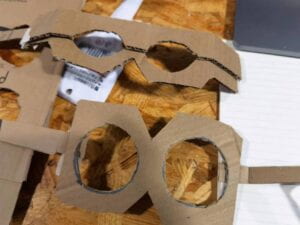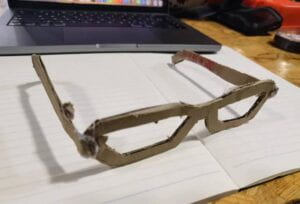Team 6: Anya Zhukova, Xiangyi Zhong, Douaa Zouhir, Luciana Emerson, Yunyi Yang, Ruiqi Zhuang
We don’t have a specific job for everyone. Basically, Anya acted as the leader since she sent the email to get us together. And we just do the majority of works together while assigning some works to specific people.
Part 1: Documentation of our own work
Before our first meet during the national holidays, we created a Google Doc which everyone can feel free to write down his or her ideas there, so that we can choose one of them and make it the theme of the project. The following is some of the ideas we put down. And since the artifact should be interactive and related with one of the three stories, while being easy to illustrate with non-electronic devices, we finally choose the glasses.

So for the crime detecting glasses, they have cameras to record what they saw and use AI to analyze it, and will alarm if they detect something looks like the crime, it involves exchange of information and receiving and responding the information, which fits all of our definitions of interaction. To be more specific, the glass gets information from the environment, process them and decide whether to alarm. Also human are to decide whether the alarm is right and may choose to let the glass show the record, both of the process involves interaction.
They were derived from the first fiction <The Veldt>, Douaa came up with the idea when seeing the children killed their parents and there was no proof to show they were guilty, and we thought that creating a scenario in our normal life could make the performance more lively and easy to understand, so we finally came up with the cable stealing incident.
We believe the artifact will be useful and convenient. It will play an important role in preventing crimes since they are easy to carry and everyone can have one so that there will be nearly no crime in places where people are gathering.
On Oct.3, we confirmed what we would do and wrote the first version of the script.
On Oct.4, We made the gadgets with cardboard in 826 the IMA Studio. We first wanted to make one pair of glasses that would turn red with flipping the cardboard, but without glass the person who wore the glasses can’t see. After two failed tryings we wanted to switch the mode. The following are failed ones.
.
So finally we turned back to the original ideas: Make two glasses and the professor will try to change them during the performance while the audience’s attention are on the students stealing the cable. We made the glasses using the sunglasses of Anya as a model. We made three pairs for fear that we may destroy the glasses when applying colors, Here’s the photo and the sketch of the glasses.
.


How to give the glasses colors? First we thought of using paint, but then someone came up with a cooler idea: Using cables and solders, cables are red and solders are silver, and we believed they would be eye-catching. 

Plus, when we put cables on the frame of the glasses, we found it hard to balance when putting them on, so we put solders on the ends of the two feet to make it balanced.
For the board that indicates time, Xiangyi made them herself.
On Oct.5, We gather together to rehearse, finding the whole performance too short, we added some more lines and one more scene: the slow-motion replay, and here’s the final version of the script.
| Characters:
Teacher Ricky Narrator: Xiangyi Student 1: Luciana Student 2: Anya Student 3: Joy Authority: Douaa Glasses’ idea (the Veldt) Teacher: Attention! You have 5 min left to complete your project. Student 1: Look what I got (waves the dongle around before putting it in their pocket) Student 2: No way I want one! Student 3: Don’t do that you are gonna get in trouble. Student 1: Don’t worry the professor isn’t even looking. Student 3: But he’s gonna notice that one is missing. Student 1: wanna bet? Teacher: Time’s up! class is dismissed. Everyone have a good day! (students start leaving as professor counts the cables) Students: Teacher: WAIT! I am missing a dongle and I know one of you took it. I’ll give you one chance to give it back. Student 1: You are crazy Student 2: Maybe you just miss counted check again Teacher: We’ll see about that tomorrow.
Student 3: Professor, I saw her steal the cable, but I have no proof! What should we do? Teacher: I’ll figure that out, see you tomorrow! Thank you for telling me. Later that day Teacher: (walks up to authorities) Is this the public safety office? Authority: Yes how can I help you? Teacher: I have a rotten thief in my classes that is stealing my dongles. I need something that will help me catch him. Authority: Here, these are crime detector glasses, this is an advanced technology that allows you to detect illegal actions, wear these glasses tomorrow. If they detect anything they will react and transmit the information straight to me! One recitation later (teacher enters classroom) Students: hello professor! Teacher: let’s begin our recitation! (the student walks in) Student 2: Today is my day. I’m gonna get one too. Student 1: Okay man let’s see if you can pull it off. Student 3: No don’t he’s wearing the glasses! Student 2: We have no proof that those even work. Student 1: Yeah I heard they are fake Student 3: But guys look there is a camera there, it’s recording your every move! Student 2: I don’t believe in technology! Let’s try it out, Here I go Teacher: I knew it! You in big trouble. Glasses turn red and make a sound: Beep beep cable stolen Authority: (runs in and says): you’re under arrest for stealing school property please follow me to our office. (proceeds to throw away dongle) Student 2: What? you have no proof Authority: Yes I do the glasses turned red! (Student 2 runs away and authority proceeds after him, but stays) Authority: Oh, let her run! We don’t really need her to do that. Teacher: How are we going to catch her then? Authority: The glasses are the key. They have cameras and all the needed footage. Let’s watch it. Teacher: Oh really? Authority: Yeah! I will click this and it will show the projection of the footage of the crime! (the narrator installs the camera frame and students come in) Student 2: (SLOWLY) Here I go (putting the wire away) Teacher: Oh that’s it! Authority: Yeah! We can stop right here! See, these crime detection glasses are truly awesome! We can end crime everywhere!
|
After rehearsal, we made the frame of the “screen” to show the slow-motion replay
And I came up with the idea of adding a pause sign. We can use cable to hang it and let it fall down when the “replay ends”, after several times of trying, we succeeded. Here’s also a illustration video
.
Finally it’s performance time! here’s the record of that.
During the whole process of making and performance. I took part in all of the group discussions and rehearsals. I helped to create the script. I also helped to make the glasses and the frame of the ‘screen’.
Part 2: Analysis and assessment of performance of other groups.
Their performance is based on the story <The Plague>. By showing a patient being cured, the group introduced a device which is similar to a car washing machine, that will give the patient a thorough cure. It is a quite relevant one since they have the similar background.
The gadgets they made are really awesome, the appearance were cool, and they used tin foil to show the machine that used light to kill bacteria, which is creative. Their performance was quite interesting. although they used a simple scene to show the device, their ways of expressing are quite lively and attracting, for example, the way the patient show how the device works and the way they present automatic gates and robots. The whole performance really meats the criteria given. They showed how the machine works instead of telling, and they made it quite creative.
However, I do think there exists a problem, which is a crucial one, that is, their artifact isn’t interactive according to the the definition of interaction of our group. Interaction should involve input of information, processing the information and output of information from both sides. When the patient enters the machine, the doctor pressed a button, and the machine started the progress of curing him, through the whole process, I don’t think there is a interaction between the machine and the patient or the machine and the doctor. It’s more like press the ‘start’ button, and it starts to run a program: everything is totally mechanic. My suggestion to tackle with the problem is that they can add another scene showing a different patient and the different respond of the machine. By doing this, we can see the input of information and feedback referring to that input
To sum up, the artifact is not very interactive but the performance is very good.